Lakeland, Florida
| City of Lakeland | |
|---|---|
| City | |
|
Downtown Lakeland | |
 Location in Polk County and the state of Florida | |
| Coordinates: 28°2′28″N 81°57′32″W / 28.04111°N 81.95889°WCoordinates: 28°2′28″N 81°57′32″W / 28.04111°N 81.95889°W | |
| Country | United States |
| State | Florida |
| County | Polk |
| Settled | c. 1875 |
| Incorporated (city) | January 1, 1885 |
| Government | |
| • Type | Commission-Manager |
| • Mayor | Howard Wiggs (2014) |
| • City Manager | Anthony "Tony" Delgado |
| Area[1] | |
| • City | 74.93 sq mi (194.06 km2) |
| • Land | 65.91 sq mi (170.70 km2) |
| • Water | 9.02 sq mi (23.36 km2) 10.9% |
| Elevation | 197 ft (60 m) |
| Population (2010)[2] | |
| • City | 97,422 |
| • Estimate (2016)[3] | 106,420 |
| • Density | 1,614.68/sq mi (623.43/km2) |
| • Metro | 584,383 |
| Census Bureau American Community Survey | |
| Time zone | EST (UTC-5) |
| • Summer (DST) | EDT (UTC-4) |
| ZIP code | 33801–33815 |
| Area code(s) | 863 |
| FIPS code | 12-38250[4] |
| GNIS feature ID | 0294459[5] |
| Website | http://www.lakelandgov.net/ |
| Twinned with Richmond Hill, Ontario; Imabari, Ehime, Japan; Bălți, Moldova; Portmore, Jamaica; and Chongming County, Shanghai, China | |
Lakeland is a city in Polk County, Florida, United States, located on Interstate 4 east of Tampa. According to the 2013 U.S. Census Bureau estimate, the city had a population of 100,710.[2] Lakeland is a principal city of the Lakeland–Winter Haven Metropolitan Statistical Area (coterminous with Polk County), which had an estimated population of 623,009 in July 2013 based on data from the University of Florida Bureau of Economic and Business Research. It is twinned with Richmond Hill, Ontario; Imabari, Ehime, Japan; Bălți, Moldova; Portmore, Jamaica; and Chongming County, Shanghai, China through the Lakeland chapter of Sister Cities International.
Native Americans began to live in the area 12,000 years ago. White settlers arrived in Lakeland in the 1870s and the city expanded in the 1880s with the arrival of rail service. Lakeland is home to the 1,267-acre Circle B Bar Reserve.
History
Prehistory
The first Paleo-Indians reached the central Florida area near the end of the last ice age, as they followed big game south.[6][7] As the ice melted and sea levels rose, these Native Americans ended up staying and thrived on the peninsula for thousands of years. By the time the first Spanish conquistadors arrived, more than 250,000 Native Americans were living on the peninsula. Some of these first early tribes were the Tocobago, Timucua, and Calusa. In 1527, a Spanish map showed a settlement near the Rio de la Paz.[6][7] The arrival of the Spanish turned out to be disastrous to these Native American tribes. Within 150 years, the majority of the pre-Columbian Native American peoples of Florida had been wiped out. Those who had not succumbed to diseases such as smallpox or yellow fever were either killed or enslaved.[6][7][8][9] Little is left of these first Native Americans cultures in Polk County except for scant archaeological records, including a few personal artifacts and shell mounds. Eventually, the remnants of these tribes merged with the Creek Indians who had arrived from the north and became the Seminole Indian tribe.[7][9]
Early history
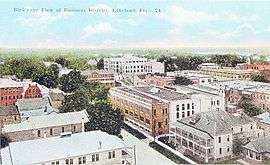
Florida became a state in 1845, and Polk County was established in 1861. After the American Civil War, the county seat was established southeast of Lakeland in Bartow. While most of the early history of Polk County centered on the two cities of Bartow and Fort Meade, eventually, people entered the areas in northern Polk County and began settling in the areas which became Lakeland.
Lakeland was first settled in the 1870s and began to develop as the rail lines reached the area in 1884. It was incorporated January 1, 1885. The town was founded by Abraham Munn (a resident of Louisville, Kentucky), who purchased 80 acres (320,000 m2) of land in what is now downtown Lakeland in 1882 and platted the land for the town in 1884. Lakeland was named for the many lakes near the town site.[10]
In April 1898, the Spanish–American War began and started a crucial point in Lakeland's development. While the war ended quickly and had little impact on most of the nation, the Florida peninsula was used as a launch point for the war and the then small town of Lakeland housed over 9,000 troops.[11]
The Florida boom resulted in the construction of many significant structures in Lakeland, a number of which are today listed on the National Register of Historic Places. This list includes the Terrace Hotel, New Florida Hotel (Regency Tower, currently Lake Mirror Tower), Polk Theatre, Frances Langford Promenade, Polk Museum of Art (not a product of the 1920s boom), Park Trammell Building (formerly the Lakeland Public Library and today the Lakeland Chamber of Commerce), and others. The city also has several historic districts with many large buildings built during the 1920s and 1940s. The Cleveland Indians held spring training there from 1923 to 1927 at Henley Field Ball Park. Parks were developed surrounding Lake Mirror including Barnett Children's Park, Hollis Gardens, and the newest, Allen Kryger Park.
The "boom" period went "bust" quickly, and years passed before the city recovered. Part of the re-emergence was due to the arrival of the Detroit Tigers in 1934 for spring training. The Tigers still train at Lakeland's Joker Marchant Stadium and own the city's Class A Florida State League team, the Lakeland Flying Tigers. In the mid-1930s, the Works Progress Administration built the Lakeland Municipal Airport.
In 1938, Florida Southern College President Ludd Spivey invited architect Frank Lloyd Wright to design a "great education temple in Florida."[12] Wright worked on the project over a period of 20 years as Spivey found ways to fund the project and to find construction workers during World War II.[12] Wright's original plan called for 18 structures, in total he designed 30, but only 12 were completed.[13] Wright's textile block motif is used extensively on the campus, and the concrete blocks he used are in need of restoration.[14]
Wright titled the project Child of the Sun, describing his Florida Southern buildings as being "out of the ground, into the light, a child of the sun."[15] It is the largest single-site collection of Frank Lloyd Wright buildings in the world, and attracts 30,000 visitors each year.[13] In 1975, the "Florida Southern Architectural District" was added to the National Register of Historic Places.[13] In 2012, Wright's campus was designated a National Historic Landmark by the National Park Service.
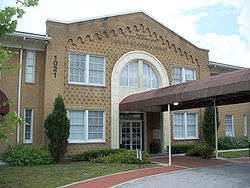
World War II
At the beginning of World War II, the Lakeland School of Aeronautics—headquartered at the recently-built Lakeland Municipal Airport—became part of a nationwide network of civilian flight schools enjoined for the war effort by the United States Army Air Corps.[16]
Between 1940 and 1945, more than 8,000 Army Air Corps and Army Air Forces cadets trained on two-seater Stearman PT-17 and PT-13 biplanes at the school (renamed the Lodwick School of Aeronautics in the midst of this period).[16]
From June 1941 until October 1942, 1,327 British Royal Air Force cadets trained at the Lakeland facility.[16]
The Lodwick School of Aeronautics closed in 1945.[16] The airport ceased flight operations in the 1960; the site has since then housed the Detroit Tigers' "Tiger Town" baseball complex.[16]
Geography and climate
According to the United States Census Bureau, the city has a total area of 67 sq mi (173.5 km2), of which 45.84 sq mi (118.7 km2) is land and 5.61 sq mi (14.5 km2) (10.90%) is covered by water. Lakeland is located within the Central Florida Highlands area of the Atlantic coastal plain, with a terrain consisting of flatland interspersed with gently rolling hills.[17]
Lakes
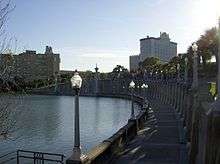
The dominant feature in Lakeland is the city's many lakes. Thirty-eight lakes are named, with a number of other bodies of water unnamed, mostly phosphate mine pits that eventually filled with water.[18][19] The largest of these is Lake Parker, which is 2,550 acres (10.3 km2) in size. Much of the culture of Lakeland revolves around its many lakes, and many people use the lakes as reference points in much the same way that people in other towns use streets as reference points, such as "I live near Lake Beulah." In addition to Lake Parker, some of the more prominent lakes in the Lakeland area are Lake Hollingsworth, Lake Morton, Lake Mirror, and Lake Gibson.
Swans are one of the most visible features on the lakes of Lakeland. They have a long history, the first swans appearing around 1923. By 1954, the swans were gone, eradicated by alligators and pets. A Lakeland resident who mourned the passing of the swans wrote to Queen Elizabeth. The royal family allowed the capture of two of the royal swans, and the swans now on the lakes of Lakeland are the descendants of the royal swans sent by the queen.
In July 2006, Scott Lake, one of the city's lakes, was almost totally drained by a cluster of sinkholes.[20] The lake later partially refilled .[21]
Climate
Lakeland, like most other parts of Florida north of Lake Okeechobee, is located in the humid subtropical zone (Köppen climate classification: Cfa).[22] Typically, summers are hot and humid with high temperatures seldom dropping below 90 °F and 70 °F for the overnight low. Like most of Central Florida, afternoon thunderstorms are the norm throughout the summer. Winters in Lakeland are drier and mild, with frequent sunny skies. High temperatures range in the low 70s during the day, with lows in the 50s. Rare cold snaps drop temperatures below freezing every few years.
| Climate data for Lakeland (LAL), 1981-2010 normals, extremes 1948-present | |||||||||||||
|---|---|---|---|---|---|---|---|---|---|---|---|---|---|
| Month | Jan | Feb | Mar | Apr | May | Jun | Jul | Aug | Sep | Oct | Nov | Dec | Year |
| Record high °F (°C) | 87 (31) |
90 (32) |
92 (33) |
95 (35) |
103 (39) |
105 (41) |
102 (39) |
100 (38) |
98 (37) |
96 (36) |
93 (34) |
87 (31) |
105 (41) |
| Average high °F (°C) | 73.6 (23.1) |
76.9 (24.9) |
81.0 (27.2) |
85.7 (29.8) |
90.7 (32.6) |
93.2 (34) |
93.9 (34.4) |
94.2 (34.6) |
91.7 (33.2) |
86.6 (30.3) |
79.9 (26.6) |
74.5 (23.6) |
85.2 (29.6) |
| Average low °F (°C) | 50.2 (10.1) |
52.5 (11.4) |
56.2 (13.4) |
60.0 (15.6) |
66.5 (19.2) |
71.7 (22.1) |
72.8 (22.7) |
73.1 (22.8) |
72.1 (22.3) |
66.0 (18.9) |
58.5 (14.7) |
52.3 (11.3) |
62.7 (17.1) |
| Record low °F (°C) | 20 (−7) |
27 (−3) |
25 (−4) |
35 (2) |
47 (8) |
56 (13) |
64 (18) |
63 (17) |
62 (17) |
42 (6) |
28 (−2) |
20 (−7) |
20 (−7) |
| Average precipitation inches (mm) | 2.59 (65.8) |
2.67 (67.8) |
3.68 (93.5) |
2.54 (64.5) |
3.19 (81) |
8.74 (222) |
7.88 (200.2) |
7.51 (190.8) |
6.10 (154.9) |
2.60 (66) |
1.79 (45.5) |
2.88 (73.2) |
52.17 (1,325.2) |
| Average rainy days (≥ 0.01 in) | 7.8 | 7.4 | 7.8 | 6.4 | 7.5 | 14.4 | 17.1 | 16.8 | 12.4 | 6.9 | 6.4 | 5.9 | 116.8 |
| Mean monthly sunshine hours | 203.2 | 209.4 | 258.2 | 302.1 | 306.7 | 255.8 | 255.4 | 248.9 | 226.5 | 239.9 | 213.4 | 203.5 | 2,923 |
| Source: [23] | |||||||||||||
Government and politics
Lakeland is governed by a six-member city council. Four members are elected from districts; the other two are elected at large. The mayor is elected.
Law enforcement
Officers killed on duty
Lakeland made national headlines on September 28, 2006, when Polk County Sheriff's Deputy Vernon "Matt" Williams and his K-9 partner Diogi were shot and killed after a routine traffic stop in the Wabash area of Lakeland. More than 500 police officers from a variety of law enforcement agencies joined in a search for Angilo Freeland, suspected of murdering Williams and then stealing his gun.
Freeland was found hiding in a rural area the next morning. Nine officers from five different law enforcement agencies surrounded Freeland and shot him when he raised Williams' stolen gun at them. A total of 110 shots were fired and Freeland was hit 68 times, killing him instantly.[24][25] Multiple investigations concluded the officers' use of force was justified.[26] Deputy Williams and Diogi were laid to rest on October 3, 2006, after a funeral that included a one-hour-and-45-minute procession to Auburndale.[27]
On December 18, 2011, Lakeland Police Officer Arnulfo Crispin was shot and killed after he stopped five young men while on a routine patrol. Crispin was 25 years old, and an 18-month veteran of the force. Kyle Williams was convicted of the killing and sentenced to life in prison.[28]
Police canine unit
The Lakeland Police Department is recognized as having one of the best-trained canine units in the United States. At the annual USPCA Police Dog Field Trials—the largest competition of police dogs in the United States—Lakeland police dog "Nox" took first place in 2015, "Bruno" took first place in 2012 and 2013, and "Charief" took second place in 2009 and 2011.[29][30][31]
Misconduct
In October 2010, Officer Rawn Haynes was arrested and charged with negligence for having left a weapon in a car with two young boys. One of the children found the gun and shot the other boy in the hand. Officer Haynes was suspended with pay after his arrest.[32]
In June 2011, Sergeant Steven Sealy was suspended from the department for reportedly interfering with the investigation of police Lieutenant Ralph Schrader. Schrader had been convicted in January 2010 of stalking his ex-wife.[33]
In July 2013, the county prosecutor released a report that "revealed an extraordinary amount of sexual conduct that was committed both on-duty and off-duty" with a single woman. As a result of the report, an assistant chief of the department retired while five officers were placed on various forms of modified duty. "Had these members of your department been more focused on the important responsibilities of law enforcement, rather than pursuing sexual encounters with a civilian analyst, LPD might not be in the condition it is today", the report concluded.[34] Sergeants Rusty Longaberger and David Woolverton were fired for conduct unbecoming, failure to report misconduct, and neglect of duty.[35]
In late January 2014, the State Attorney's Office investigated hiring practices in the department due to allegations of improper handling of the 2012 job application of the nephew of Chief Lisa Womack. The chief had already announced she would leave her position on May 1, 2014. She was placed on administrative leave in January 2014. One city councilman, Justin Troller, commented, "Let's pay her and move on."[36]
Demographics
| Historical population | |||
|---|---|---|---|
| Census | Pop. | %± | |
| 1890 | 552 | — | |
| 1900 | 1,180 | 113.8% | |
| 1910 | 3,719 | 215.2% | |
| 1920 | 7,062 | 89.9% | |
| 1930 | 18,554 | 162.7% | |
| 1940 | 22,068 | 18.9% | |
| 1950 | 30,851 | 39.8% | |
| 1960 | 41,350 | 34.0% | |
| 1970 | 42,803 | 3.5% | |
| 1980 | 47,406 | 10.8% | |
| 1990 | 70,576 | 48.9% | |
| 2000 | 78,452 | 11.2% | |
| 2010 | 97,422 | 24.2% | |
| Est. 2016 | 106,420 | [3] | 9.2% |
| Lakeland Demographics | |||
|---|---|---|---|
| 2010 Census | Lakeland | Polk County | Florida |
| Total population | 97,422 | 602,095 | 18,801,310 |
| Population, percent change, 2000 to 2010 | +24.2% | +24.4% | +17.6% |
| Population density | 1,492.6/sq mi | 334.9/sq mi | 350.6/sq mi |
| White or Caucasian (including White Hispanic) | 70.8% | 75.2% | 75.0% |
| (Non-Hispanic White or Caucasian) | 63.1% | 64.6% | 57.9% |
| Black or African-American | 20.9% | 14.8% | 16.0% |
| Hispanic or Latino (of any race) | 12.6% | 17.7% | 22.5% |
| Asian | 1.8% | 1.6% | 2.4% |
| Native American or Native Alaskan | 0.3% | 0.4% | 0.4% |
| Pacific Islander or Native Hawaiian | 0.1% | 0.1% | 0.1% |
| Two or more races (Multiracial) | 2.7% | 2.4% | 2.5% |
| Some Other Race | 2.6% | 5.5% | 3.6% |
As of 2010, 48,218 households were in the city, with 15.5% being vacant. As of 2000, 23.5% had children under the age of 18 living with them, 43.5% were married couples living together, 13.7% had a female householder with no husband present, and 39% were individuals and nontraditional families. About 32.9% of all households were made up of individuals, and 14.9% had someone living alone who was 65 years of age or older. The average household size was 2.23 and the average family size was 2.82.
As of the 2010 census, the city was 20.9% Black or African American, 70.8% White, 0.3% Native American, 1.8% Asian, 0.1% Native Hawaiian, and 2.7% were two or more races. 12.6% of the population were of Hispanic or Latino ancestry.
In 2000, the city the population was spread out with 21.4% under the age of 18, 10.3% from 18 to 24, 24.7% from 25 to 44, 20.6% from 45 to 64, and 23.0% who were 65 years of age or older. The median age was 40 years. For every 100 females, there were 86.8 males. For every 100 females age 18 and over, there were 82.1 males.
In 2000, the median income for a household in the city was $16,119, and for a family was $17,468. Males had a median income of $14,137 versus $9,771 for females. The per capita income for the city was $15,760. About 47% of families and 35% of the population were below the poverty line, including 97% of those under age 18 and 9% of those age 65 or over. In 2008-2012, the per capita income was $23,817 and the median household income was $40,284. Persons below the poverty line in 2008-2012 were 17.5% according to the US Census.[38]
Languages
As of 2000, those who spoke only English at home accounted for 91% of all residents, while 9% spoke other languages at home. The most significant were Spanish speakers who made up 6.44% of the population, while German came up as the third-most spoken language, which made up 0.75%, and French was fourth, with 0.51% of the population.[39]
Religion
In 1913, the Wolfson family arrived from Lithuania and became the first Jewish settlers to the area.[40] After some struggles, the Jewish community in Lakeland flourished and the first synagogue, Temple Emanuel opened in 1932.[41] The Rohr Jewish Learning Institute presents classes and seminars in Lakewood in partnership with Chabad of Lakeland.[42]
Lakeland is home to one of the first Hindu temples in the United States, the Swaminarayan Hindu Temple.[43]
In 1994, the first and only mosque was established. It was called Masjid Aisha, but is now called the Islamic Center of Lakeland. It was remodeled in 2011. It is located on the corner of Providence and Orange Blossom.
Christianity makes up the largest religious group in Lakeland. As of 2013, an estimated 300 churches existed with an address in the city.[44]
Economy

Lakeland is the largest city on Interstate 4 between Orlando and Tampa. Large industries in the Lakeland area are citrus, cattle, and phosphate mining. In the past few decades, tourism, medicine, insurance, transportation, and music have grown in importance.
Citrus growing dates back to the early settlers who planted trees in the area in the 1850s. After a series of freezes in counties north of Polk County, the area became the focal point for citrus growing in Florida. Although citrus is no longer the largest industry in the area, it still plays a large part in the economy of Lakeland and Polk County.
Phosphate mining is still important to the economy of Lakeland, although most of the mining now takes place further south. The Bone Valley produced 25% of the U.S. phosphate supply.
Lakeland's largest employer is Publix Supermarkets.[45] Publix is one of the largest regional grocery chains in the United States with over 1,000 stores. Publix employs over 6,500 people in the Lakeland area including headquarter and warehouse employees.
Lakeland is a transportation hub. FedEx Freight and FedEx Services and the Saddle Creek Corporation employ over 600 people in the area.[45] Other large employers in the area include Amazon,[46] GEICO, Rooms To Go, and Lakeland Regional Medical Center.[47]
Culture
Historic districts
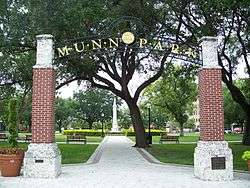
Buildings and locations
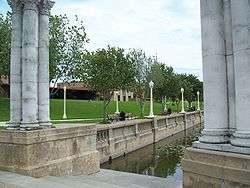
- Central Avenue School
- Cleveland Court School
- John F. Cox Grammar School
- Florida Southern College
- Henley Field Ball Park
- Joker Marchant Stadium
- Frances Langford Promenade
- Lakeland Center
- Lakeland Square Mall
- Lakeside Village
- Old Lakeland High School
- James Henry Mills Medal of Honor Parkway
- Oates Building
- Polk Community College
- Polk Museum of Art
- Polk Theatre
- Southeastern University (Florida)
- USA International Speedway
- Florida Polytechnic University
- Winston School
- Without Walls Central Church - a local/regional megachurch
- Silvermoon Drive-in
Media
Polk County is within the Tampa Bay television market. Bright House Networks is the cable television franchise serving Lakeland, which offers most television stations from the Tampa Bay market, as well as WFTV, the ABC affiliate from Orlando. WMOR-TV, an independent television station, is licensed to Lakeland, with its studios in Tampa and its transmitter in Riverview.
Lakeland and Polk County are within its own radio market. Local radio stations include:
WLLD 94.1 FM is licensed to Lakeland, but has wider focus on the Tampa Bay area, with studios in St. Petersburg. WKES 91.1 FM is also licensed to Lakeland as part of the statewide Moody Radio Florida network, with studios in Seminole, near St. Petersburg. Most major stations from Tampa Bay and a few from Orlando are also available.
The local newspaper is The Ledger, owned by Halifax Media Group.
The city magazine is "The Lakelander" published by Patterson Publishing
Popular culture

In 1990, Lakeland made its Hollywood debut when the Southgate Shopping Center was featured in the movie Edward Scissorhands. It was also used in the filming of the Judd Nelson movie Endure.[48] Classrooms from Florida Southern College were used in the Adam Sandler comedy, The Waterboy.[49]
Transportation
Because Lakeland is the largest city on Interstate 4 between Tampa and Orlando, the city is an important transportation hub. The county nickname, Imperial Polk County, was coined because a large bond issue in 1914 enabled wide roads between the cities of Polk County.[50]
The important freeways and highways in Lakeland today are:

- Interstate 4 is the main interstate in central Florida linking Tampa, Lakeland, Orlando, and Daytona Beach.
- Polk Parkway, or SR 570, is a tolled beltway around Lakeland, with both ends terminating at Interstate 4. Although its shape, location, and tolls makes it impractical as a "bypass" road, it is useful as a way of getting from part of town to another and providing access to I-4 from most parts of the city.
- US 92, following Memorial Boulevard for most of the city, was the route leading to both Tampa and Orlando before I-4 was built; US 92 is still a main road leading to Plant City going west, and Auburndale, Winter Haven, and Haines City going east.
- US 98, going south, follows Bartow Road and leads to Bartow, the county seat. Heading north out of town, it provides a route to Dade City.
- State Road 33, following mostly rural land, provides access to Lake County and the Florida Turnpike.
- State Road 37, following Florida Avenue, the main north-south route in Lakeland, is also the main road leading south to Mulberry.
- State Road 540, Winter-Lake Road, is in southern Lakeland, leading to Winter Haven and Legoland Florida.
Bicycle routes
In recent years, the Lakeland area has developed a number of paved, multi-use bicycle routes including the Lake-To-Lakes Trail, which runs from Lake Parker through downtown, past several lakes, ending at Lake John. Other routes include University Trail, which connects Polk State College to Florida Polytechnic University, and the Fort Fraser Trail, which runs along US Highway 98 from Polk State College to Highway 60 in Bartow.[51]
Public transportation
- Lakeland Amtrak Station
- Lakeland Linder Regional Airport
- Lakeland Greyhound Terminal
- Citrus Connection local bus service.[52]
Education

The 28 elementary schools, seven middle schools, five traditional high schools, and three magnet-choice high schools in the Lakeland area are run by the Polk County School Board.
Traditional public high schools
Magnet high schools
- Central Florida Aerospace Academy
- Lois Cowles Harrison Center for the Visual and Performing Arts
- Polk State College Lakeland Collegiate High School
Traditional public middle schools
- Kathleen Middle School
- Lake Gibson Middle School
- Crystal Lake Middle school
- Sleepy Hill Middle School
- Lakeland Highlands Middle School
- Southwest Middle School
Magnet middle schools
- Lawton Chiles Middle School
- Rochelle School of the Arts (elementary and middle)
Charter schools
- McKeel Academy of Technology
- Lakeland Montessori Schoolhouse
- Lakeland Montessori Middle School
- Lakeland Collegiate High school
Private schools
- Calvary Baptist Church Academy
- Geneva Classical Academy
- Heritage Christian Academy
- Highlands Christian Academy
- Lakeland Christian School
- Resurrection Catholic School
- Santa Fe Catholic High School
- Sonrise Christian School
- St Anthony
- St Joseph
- St Lukes
- St Paul Lutheran School
- Victory Christian Academy
Colleges and universities
A number of opportunities exist for higher education around the Lakeland area. Southeastern University is the largest university in the area, with an enrollment around 2800.[53] Southeastern is affiliated with the Assemblies of God. Florida Southern College, established in 1883 and with a current enrollment of just over 2000,[54] is located on Lake Hollingsworth. Florida Southern is the home of the world's largest single-site collection of Frank Lloyd Wright architecture. In July 2008, the University of South Florida's Lakeland campus was granted partial autonomy by Governor Charlie Crist and became Florida Polytechnic University. Florida Polytechnic (FLPoly) is located just inside the Lakeland's northeast border at the intersection of I-4 and Polk Parkway. They also have some administrative offices on the campus of Polk State College on Winter Lake Road. FLPoly is focused on STEM degree programs, such as engineering and computer science.[55] Both Everest University and Keiser University, two multisite, accredited universities, have locations in Lakeland. Traviss Career Center is a vocational school.[56] Webster University offers on-site, regionally accredited graduate degree programs in business and counseling at their Lakeland Metropolitan Campus[57]
Sports
| Club | Sport | Founded | Current League | Stadium |
|---|---|---|---|---|
| Lakeland Flying Tigers | Baseball | 1963[58] | Florida State League | Publix Field at Joker Marchant Stadium |
| Gulf Coast League Tigers | Baseball | 1995[59] | Gulf Coast League | Publix Field at Joker Marchant Stadium |
| Lakeland Magic | Basketball | 2008[60] | NBA G League | RP Funding Center |
| Central Florida Jaguars | Football | 2015[61] | Elite Indoor Football Conference | Bartow Park |
| Southeastern Fire | Football | 2014[62] | NAIA | Victory Field |
| Florida Tropics SC | Indoor Soccer | 2016[63] | Major Arena Soccer League | RP Funding Center |
Stadiums
Joker Marchant Stadium, north of downtown, hosts spring training for the Detroit Tigers, as well as their Lakeland Flying Tigers class-A Florida State League and GCL Tigers rookie-league Gulf Coast League minor league baseball teams.
RP Funding Center is also home to two indoor sports teams: the Central Florida Jaguars, an indoor football team playing in the Elite Indoor Football Conference and the Florida Tropics SC, an indoor soccer team playing in the Major Arena Soccer League. The Tropics organization also operates an outdoor team, the Lakeland Tropics, who compete in the Premier Development League.
Starting with the 2017–18 season, Lakeland will be home to the Lakeland Magic, a developmental basketball team affiliated with the Orlando Magic of the National Basketball Association and play home games at the RP Funding Center.
History of sports teams in Lakeland
In the 1980s, the Lakeland Center briefly played host to the indoor version of the Tampa Bay Rowdies soccer team. The Lakeland Center has also hosted a few hockey teams, the Lakeland Ice Warriors, the Lakeland Prowlers, and the Lakeland Loggerheads. The United States Basketball League once had a team here as well called the Lakeland Blue Ducks. Sun 'n Fun was home to Lakeland's only roller derby league, the Lakeland Derby Dames; however, the team was dissolved in November 2015.[64]
The Lakeland Center also hosts the Florida High School Athletic Association's state basketball finals.
Sister cities
 Bălți, Moldova
Bălți, Moldova Chongming County, Shanghai, China
Chongming County, Shanghai, China Imabari, Ehime, Ehime, Japan
Imabari, Ehime, Ehime, Japan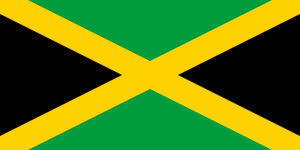 Portmore, Jamaica
Portmore, Jamaica Richmond Hill, Ontario, Canada
Richmond Hill, Ontario, Canada
See also
References
- ↑ "2016 U.S. Gazetteer Files". United States Census Bureau. Retrieved Jul 7, 2017.
- 1 2 "Annual Estimates of the population for the Incorporated Places of Florida". US Census Bureau. Archived from the original (XLS) on May 8, 2009. Retrieved November 25, 2007.
- 1 2 "Population and Housing Unit Estimates". Retrieved June 9, 2017.
- ↑ "American FactFinder". United States Census Bureau. Retrieved January 31, 2008.
- ↑ "US Board on Geographic Names". United States Geological Survey. October 25, 2007. Retrieved January 31, 2008.
- 1 2 3 "Ancient Native". HOTOA. Archived from the original on October 17, 2010. Retrieved September 9, 2010.
- 1 2 3 4 "Polk County History". Polk Counjty Historical Association. Archived from the original on July 27, 2011. Retrieved September 11, 2010.
- ↑ "The Ancient Ones". HOTOA. Archived from the original on October 17, 2010. Retrieved September 9, 2010.
- 1 2 Weibel, B. "Trail of Florida's Ancient Heritage". active.com. Archived from the original on July 13, 2010. Retrieved September 9, 2010.
- ↑ Sawyer, Martha F. (July 8, 1987). "Polk towns named from various sources". Lakeland Ledger. pp. 5C. Retrieved June 6, 2015.
- ↑ "Spanish American War" (PDF). Polk County Historical Quarterly. Polk County Historical Association. June 2003. p. 6. Archived from the original (PDF) on April 2, 2012. Retrieved September 26, 2010.
- 1 2 "Frank Lloyd Wright’s Fla. campus - The Boston Globe". www.bostonglobe.com. Retrieved 2017-04-01.
- 1 2 3 MacDonald, Randall M.; Galbraith, Nora E.; Rogers, James G. (2007-01-01). The Buildings of Frank Lloyd Wright at Florida Southern College. Arcadia Publishing. ISBN 9780738552798.
- ↑ Sussingham, Robin. "New Frank Lloyd Wright House Constructed at Florida Southern". Retrieved 2017-04-01.
- ↑ Storrer, William Allin; Wright, Frank Lloyd (2002-04-15). The Architecture of Frank Lloyd Wright: A Complete Catalog. University of Chicago Press. ISBN 9780226776224.
- 1 2 3 4 5 LEDGER, GARY WHITE THE. "Flight Cadets Attended Lakeland School of Aeronautics". The Ledger. Retrieved 2017-04-01.
- ↑ "Florida's Geological History". University of Florida. Retrieved October 14, 2010.
- ↑ "Measurement of Recovery in Lakes Following Phosphate Mining" (PDF). Florida Institute of Phosphate Research. Retrieved February 4, 2014.
- ↑ "Frequently Asked Questions". Lakeland, Florida. Retrieved February 4, 2014.
- ↑ Diane Lacey Allen (June 23, 2006). "'The Lake is Dry'". The Ledger. Retrieved November 25, 2007.
- ↑ "Florida Lake Swallowed by Sinkhole Reappearing". Associated Press. July 25, 2006. Retrieved November 25, 2007.
- ↑ "World Map of the Köppen-Geiger climate classification updated". University of Veterinary Medicine Vienna. November 6, 2008. Archived from the original on September 6, 2010. Retrieved September 10, 2010.
- ↑ http://www.nws.noaa.gov/climate/xmacis.php?wfo=mlb
- ↑ Waddell, Lynn (October 13, 2006). "68 Bullets". Newsweek.
- ↑ "Autopsy: Officers fired 110 rounds at man suspected in cop's death". Sunbeam Television Corp. September 30, 2006.
- ↑ Walter, Shoshana (June 5, 2008). "Killer's Civil Rights Not Violated, Panel Says". TheLedger.com.
- ↑ Stegall, Sarah (October 4, 2006). "Thousands Turn Out to Say 'Thank You'". TheLedger.com.
- ↑ Dulaney, Cody (August 26, 2014). "Judge Sentences Kyle Williams to Life in Prison for Murder of LPD Officer Crispin". The Ledger.
- ↑ "USPCA National Field Trials" (PDF). United States Police Canine Association.
- ↑ "2013 National Patrol Dog Field Trials" (PDF). United States Police Canine Association. Archived from the original (PDF) on February 1, 2014.
- ↑ "National 2011 USPCA Police Dog Field Trials" (PDF). United States Police Canine Association.
- ↑ LPD Officer Arrested, Suspended, The Ledger, October 21, 2010
- ↑ Police Sgt. Sealey Suspended Over Schrader Inquiry, by Jason Geary, The Ledger, June 10, 2011
- ↑ Florida police officers entangled in widespread sex scandal, Associated Press, July 10, 2013
- ↑ Two Lakeland police sergeants fired in wake of major sex scandal, by Chris Trenkmann, July 15, 2013, WFTS
- ↑ LPD Chief Lisa Womack Put on Administrative Leave; Police chief suspended after report about her nephew's job search at LPD is released, by Jeremy Maready & Rick Rousos, January 31, 2014, The Ledger
- ↑ "Census of Population and Housing". Census.gov. Retrieved June 4, 2015.
- ↑ "Lakeland (city) QuickFacts from the US Census Bureau". census.gov. Retrieved December 10, 2014.
- ↑ Modern Language Association Data Center Results of Lakeland, Florida.
- ↑ "First Jewish Settlers" (PDF). Polk County Historical Association. October 2002. p. 1. Retrieved September 26, 2010.
- ↑ "Temple Emanuel History" (PDF). Billy. October 2002. Retrieved September 26, 2010.
- ↑ Steve, Steiner (August 2015). "Two-part seminar to examine torture, negotiating". The Polk County Democrat.
- ↑ "Religion in Polk". Lakeland. Retrieved September 26, 2010.
- ↑ name="Counting Lakeland's Churches""Churches in Lakeland, FL". Retrieved December 2, 2013.
- 1 2 "Lakeland Demographics Guide 2010" (PDF). City of Lakeland. Retrieved September 18, 2010.
- ↑ Brinkman, Paul (August 21, 2014). "Amazon welcomes employees in Lakeland; drones in India?". Orlando Sentinel. Retrieved November 20, 2016.
- ↑ "LAKELAND, FL AREA MAJOR EMPLOYERS" (PDF). Lakeland Development Council. Retrieved November 20, 2016.
- ↑ White, Gary (March 3, 2009). "Lakeland Filmmakers Snag Judd Nelson". TheLedger.com.
- ↑ Erickson, Stephanie (October 13, 2005). "Have any movies been filmed in Polk County?". Orlando Sentinel. Retrieved April 25, 2014.
- ↑ "Why Imperial Polk". Polk County Website. Retrieved September 10, 2010.
- ↑ "Trails and Facilities". Retrieved April 5, 2016.
- ↑ "Citrus Connection". ridecitrus.com. Retrieved December 10, 2014.
- ↑ "Southeastern University". cappex.com. Retrieved March 12, 2014.
- ↑ "Florida Southern College". US News and World Report. Retrieved March 12, 2014.
- ↑ "About Florida Polytechnic University". Florida Polytechnic University. Retrieved January 30, 2017.
- ↑ "Traviss Career Center | Lakeland, Florida". Traviss.edu. Retrieved November 1, 2012.
- ↑ "Lakeland". webster.edu. Retrieved December 10, 2014.
- ↑ "Club Information". Baseball-Reference.com. Retrieved August 4, 2017.
- ↑ "Club Information". Baseball-Reference.com. Retrieved August 4, 2017.
- ↑ "Orlando Magic begin process of bringing D-League team to Florida". Orlando Sentinel. Retrieved August 4, 2017.
- ↑ "Jags announce membership in EIFC". Elite Indoor Football Conference. Retrieved August 4, 2017.
- ↑ "This is what a program’s first home game ever should look like". FootballScoop.com. Retrieved August 4, 2017.
- ↑ "http://www.fltropics.com/news/florida-tropics-sc-join-major-arena-soccer-league". FLTropics.com. Retrieved August 4, 2017. External link in
|title=(help) - ↑ "Roller derby is back in Lakeland". TheLedger.com. Retrieved August 4, 2017.


